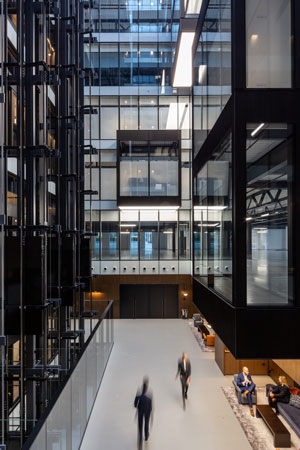SSDA Awards
COMMENDATION: 60 London Wall

A tired and outdated steel-framed office block has been partially retained and enlarged with new steelwork to create a modern City commercial development.
FACT FILE
Architect: EPR Architects
Structural engineer: Heyne Tillett Steel
Steelwork contractor: Severfield
Main contractor: Skanska
Client: La Salle Investment Management
Located in the Square Mile, 60 London Wall is a complex redevelopment of an existing post-modern office block. Previously a tired and outdated steel-framed building, the seven-storey structure has been partially retained, strengthened and redeveloped to create a new 11-storey structure with adaptable floorplates and a new communal atrium running through the heart of the structure.
“The use of new steelwork to refurbish and extend the existing building has provided a cost-effective structural solution for the client, delivering a modern, high-quality office with prime retail accommodation at ground level,” says Heyne Tillett Steel Associate Director Andrew Howe.
Beginning on site in mid-2017, the initial works involved a detailed programme of demolition and enabling works to prepare the building for redevelopment and reuse. The building’s fabric was then removed and stripped back to the original steel frame. From there, the top floor was removed and replaced with a five-storey steel-framed extension, increasing the structure to 11-storeys and upping the overall floor area by 50%.
The building’s extensions are formed from new steelwork, requiring a complex coordination programme to integrate the new and existing steel frames. This required a substantial number of new connection designs to support the new framing and ensure level finishes between floor levels.
By opting to reuse much of the steel frame, the original columns and beams were surveyed and back analysed to ensure they could carry the additional loads from the new floors and to keep strengthening works to a minimum.
Only 60 of the existing columns (equating to around 10%) needed strengthening with the remaining frame reused and proven.
Internally, much of the new and existing steelwork has been left exposed, giving the lettable floor area a modern, industrial aesthetic. The existing steelwork had previously been encased in concrete. To provide the required finish and match the building’s new steel elements, the steelwork was broken out of its concrete shell, shot blasted, primed and then painted with a high-spec coating system.
The character of the building has been carefully reconsidered. At the heart of the building, a dramatic glazed atrium has been installed, opening up sightlines and increasing natural light levels while the two remaining pre-existing atria have been infilled, increasing the floor area.
The new curvilinear glazed façades are elegantly finished with a contemporary palette responding to the rich, historical context of the City of London. Increased glazing greatly improves natural light onto the floorplates, while vertical stone brise soleil creates a solidity when viewed along London Wall, which reduces solar gain.
Forming a series of new greened terraces, the floorplates step back from the façade line above the fifth floor. A series of steel transfer beams, up to 10t in weight, have been provided at each floor to support the set-backs.
In summary, the judges say, through careful analysis of the existing structure, this redevelopment has provided a 50% increase in floor area, including the addition of five new floors. The existing areas have been significantly improved with the steel structure exposed and a new atrium added, resulting in major savings in carbon. An excellent achievement.










